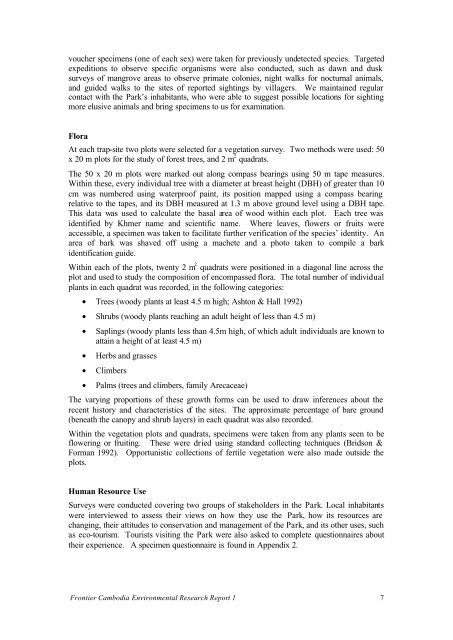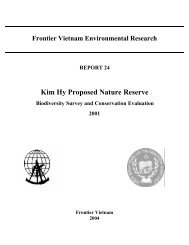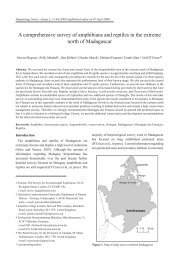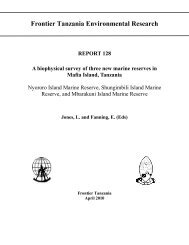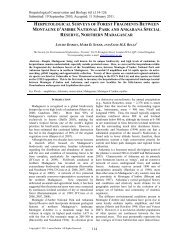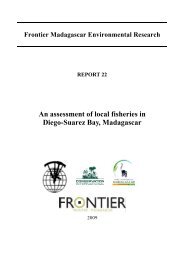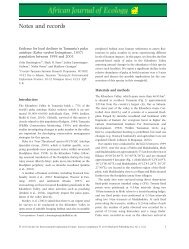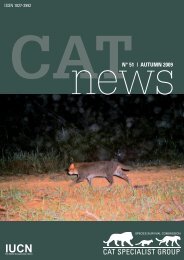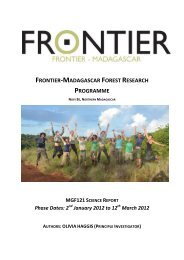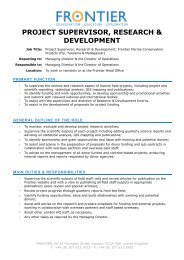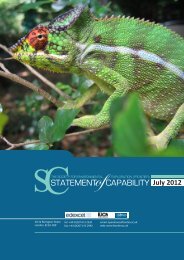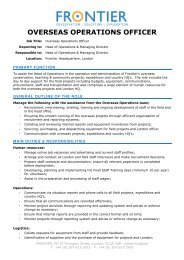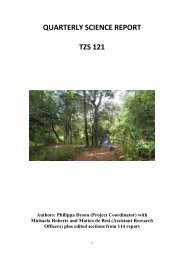Ream National Park Twelve Month Report
Ream National Park Twelve Month Report
Ream National Park Twelve Month Report
Create successful ePaper yourself
Turn your PDF publications into a flip-book with our unique Google optimized e-Paper software.
voucher specimens (one of each sex) were taken for previously undetected species. Targeted<br />
expeditions to observe specific organisms were also conducted, such as dawn and dusk<br />
surveys of mangrove areas to observe primate colonies, night walks for nocturnal animals,<br />
and guided walks to the sites of reported sightings by villagers. We maintained regular<br />
contact with the <strong>Park</strong>’s inhabitants, who were able to suggest possible locations for sighting<br />
more elusive animals and bring specimens to us for examination.<br />
Flora<br />
At each trap-site two plots were selected for a vegetation survey. Two methods were used: 50<br />
x 20 m plots for the study of forest trees, and 2 m 2 quadrats.<br />
The 50 x 20 m plots were marked out along compass bearings using 50 m tape measures.<br />
Within these, every individual tree with a diameter at breast height (DBH) of greater than 10<br />
cm was numbered using waterproof paint, its position mapped using a compass bearing<br />
relative to the tapes, and its DBH measured at 1.3 m above ground level using a DBH tape.<br />
This data was used to calculate the basal area of wood within each plot. Each tree was<br />
identified by Khmer name and scientific name. Where leaves, flowers or fruits were<br />
accessible, a specimen was taken to facilitate further verification of the species’ identity. An<br />
area of bark was shaved off using a machete and a photo taken to compile a bark<br />
identification guide.<br />
Within each of the plots, twenty 2 m 2 quadrats were positioned in a diagonal line across the<br />
plot and used to study the composition of encompassed flora. The total number of individual<br />
plants in each quadrat was recorded, in the following categories:<br />
• Trees (woody plants at least 4.5 m high; Ashton & Hall 1992)<br />
• Shrubs (woody plants reaching an adult height of less than 4.5 m)<br />
• Saplings (woody plants less than 4.5m high, of which adult individuals are known to<br />
attain a height of at least 4.5 m)<br />
• Herbs and grasses<br />
• Climbers<br />
• Palms (trees and climbers, family Arecaceae)<br />
The varying proportions of these growth forms can be used to draw inferences about the<br />
recent history and characteristics of the sites. The approximate percentage of bare ground<br />
(beneath the canopy and shrub layers) in each quadrat was also recorded.<br />
Within the vegetation plots and quadrats, specimens were taken from any plants seen to be<br />
flowering or fruiting. These were dried using standard collecting techniques (Bridson &<br />
Forman 1992). Opportunistic collections of fertile vegetation were also made outside the<br />
plots.<br />
Human Resource Use<br />
Surveys were conducted covering two groups of stakeholders in the <strong>Park</strong>. Local inhabitants<br />
were interviewed to assess their views on how they use the <strong>Park</strong>, how its resources are<br />
changing, their attitudes to conservation and management of the <strong>Park</strong>, and its other uses, such<br />
as eco-tourism. Tourists visiting the <strong>Park</strong> were also asked to complete questionnaires about<br />
their experience. A specimen questionnaire is found in Appendix 2.<br />
Frontier Cambodia Environmental Research <strong>Report</strong> 1<br />
7


